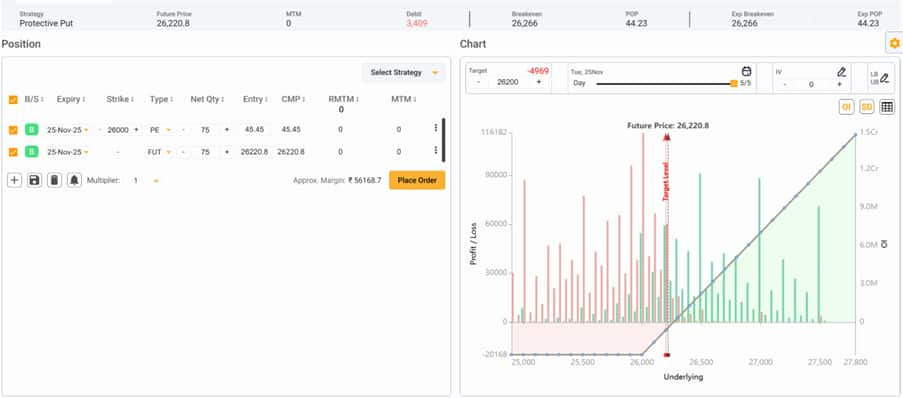What is Open Interest Put Call Ratio, and why is it a handy indicator of the market mood?
Typically, one shall be watchful as soon as OIPCR reaches its reasonably historic bottom or top like that of preceding 52 weeks.
SHUBHAM AGARWAL | 13-Jul-19
Reading Time: 3 minutes

Any attempt to trade the market more often than not starts with understanding the mood of the market. I say, mood and not direction as we are always keen on not only the direction but also its intensity.
Today, we will try and visit one of the simplest options data analytic that gives us at least a starting point if not a base for the trade when we approach the market in just a single reading without having to analyze any past.
All of us participants as a set would give away our consensus over expectations via aggregate positions more often than not, especially in the F&O market. One such consensus can be drawn out of a sentimental indicator called Open Interest Put Call Ratio (OIPCR). OIPCR calculation is very simple.
OIPCR =Total Open interest of All the Puts/Total Open Interest of All the Calls of a particular underlying, for market mood we would consider Nifty Options
Now, before we get into that, let us understand the intention that causes the action of buying or selling options.
1. Buy Call when Bullish2. Buy Put when Bearish3. Sell (Write) Call when Neutral to Bearish
4. Sell (Write) Put when Neutral to Bullish
Back to OIPCR again: like every other indicator, OIPCR also works on a simple premise of intention behind action. Now, one school of thought says Option is like insurance and the providers of Insurance, which means Option writers know more about underlying assets (in insurance it is the example our life expectancy).
It is because Option writers pay margin for a trade which would always have an unfavourable reward to risk profile. So, more writers bring in stronger intention. The idea we are trying to explore here is, if we have more Call writers than Put writers, that means the majority of writers (the wise ones) hold the expectation of Neutral to Bearish Underlying while more Put writers indicate otherwise.
Now, put the Open Interest values into OIPCR, and we would have a figure. If the OIPCR is more than one means more Put writers (Put Open Interest means both the Put writer the buyer) than Call writers. This indicates the consensus tilting towards Neutral to bullish bias by the virtue of being outnumbered. Had it been below 1, it'd be the other way around, participants’ consensus tilting towards neutral to bearish bias.
So, OIPCR more than 1 is bullish, less than 1 bearish. However, a major utility that we have found out of this indicator is much More than this. The More part is that OIPCR is also used to gauge the extremes in the market consensus (not extremes in underlying but extremes in consensus).
To put things in perspective, imagine when OIPCR goes far beyond more than 1. The mood turns from bullish to extremely bullish. Similarly, if OIPCR is closer to 0 than 1, the situation indicates an extremely bearish mood. The takeaway here is that the extreme is never sustainable, hence it would generally be a major turning point in the underlying (major top/ bottom)
Although the question of how much is too much is very tricky, it could be answered by looking at empirical evidences. Typically, one shall be watchful as soon as OIPCR reaches its reasonably historic bottom or top like that of preceding 52 weeks.
It is not an exact science. But, for over more than a decade, this one tool has time and again proved that keeping this analytic in our bag of market tools always pays-off.
Learn and read more about oi data from Quantsapp classroom which has been curated for understanding of Option Spreads from scratch, to enable option traders grasp the concepts practically and apply them in a data-driven trading approach.
Recent Articles

3 best ways to hedge using Options: Shubham Agarwal!
22-Nov-25

When in doubt to write, do Iron Fly: Shubham Agarwal!
15-Nov-25

Identify potential turning points with advance-decline: Shubham Agarwal
08-Nov-25

Slow and spreads more efficient: Shubham Agarwal
01-Nov-25

Use implied volatility as probable top finder: Shubham Agarwal
25-Oct-25

How to trade potential breakout post consolidation: Shubham Agarwal!
18-Oct-25

Use Options OI for intraday trading: Shubham Agarwal
11-Oct-25

Monetize Vega, the impact of implied volatility: Shubham Agarwal
04-Oct-25

SHUBHAM AGARWAL is a CEO & Head of Research at Quantsapp Pvt. Ltd. He has been into many major kinds of market research and has been a programmer himself in Tens of programming languages. Earlier to the current position, Shubham has served for Motilal Oswal as Head of Quantitative, Technical & Derivatives Research and as a Technical Analyst at JM Financial.
Recent Articles

3 best ways to hedge using Options: Shubham Agarwal!
22-Nov-25 09:11:00

When in doubt to write, do Iron Fly: Shubham Agarwal!
15-Nov-25 10:48:00

Identify potential turning points with advance-decline: Shubham Agarwal
08-Nov-25 10:35:00

Slow and spreads more efficient: Shubham Agarwal
01-Nov-25 10:35:00

Use implied volatility as probable top finder: Shubham Agarwal
25-Oct-25 09:56:00

How to trade potential breakout post consolidation: Shubham Agarwal!
18-Oct-25 09:20:00

Use Options OI for intraday trading: Shubham Agarwal
11-Oct-25 09:45:00











